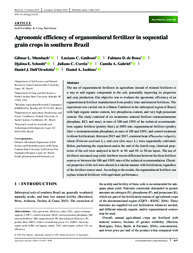Agronomic efficiency of organomineral fertilizer in sequential grain crops in southern Brazil.
Agronomic efficiency of organomineral fertilizer in sequential grain crops in southern Brazil.
Autoria: MUMBACH, G. L.; GATIBONI, L. C.; DE BONA, F. D.; SCHMITT, D. E.; CORREA, J. C.; GABRIEL, C. A.; DALL'ORSOLETTA, D. J.; IOCHIMS, D. A.
Resumo: Abstract The use of organomineral fertilizers in agriculture instead of mineral fertilizers is a way to add organic compounds to the soil, potentially improving its properties and crop production. Our objective was to evaluate the agronomic efficiency of an organomineral fertilizer manufactured from poultry litter and mineral fertilizers. The experiment was carried out in a Humic Cambisol in the subtropical region of Brazil, with high organic matter content, low phosphorus content, and very high potassium content. The study consisted of six treatments: mineral fertilizer (monoammonium phosphate, KCl, and urea), at rates of 100 and 150% of the technical recommendation; organic fertilizer (poultry litter), at 100% rate; organomineral fertilizer (poultry litter + monoammonium phosphate), at rates of 100 and 150%; and control treatment (without fertilization). Between 2015 and 2017, common bean (Phaseolus vulgaris), wheat (Triticum aestivum L.), and corn (Zea mays L.) were sequentially cultivated. Before performing the experiment and at the end of the fourth crop, chemical properties of the soil were analyzed in the 0- to 10- and 10- to 20-cm layers. The use of fertilizers increased crop yield, but there was no difference between the three fertilizer sources or between the 100 and 150% rates of the technical recommendation. Chemical properties of the soil were altered in a similar manner with fertilization, regardless of the fertilizer source used. According to the results, the organomineral fertilizer can replace mineral fertilizers with equivalent performance.
Ano de publicação: 2020
Tipo de publicação: Artigo de periódico
Unidade: Embrapa Trigo
Palavras-chave: Adubo Orgânico, Fertilidade, Fertilizante mineral, Fertilizante orgânico
Observações
1 - Por padrão são exibidas publicações dos últimos 20 anos. Para encontrar publicações mais antigas, configure o filtro ano de publicação, colocando o ano a partir do qual você deseja encontrar publicações. O filtro está na coluna da esquerda na busca acima.
2 - Para ler algumas publicações da Embrapa (apenas as que estão em formato ePub), é necessário ter, no celular ou computador, um desses softwares gratuitos. Sistemas Android: Google Play Livros; IOS: iBooks; Windows e Linux: software Calibre.
Acesse outras publicações
Acesse a Base de Dados da Pesquisa Agropecuária (BDPA) para consultar o acervo completo das bibliotecas da Embrapa.

